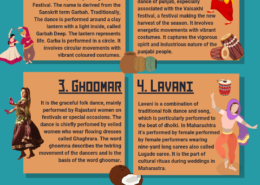What societal messages or criticism on current affairs may folk dances convey? Give instances of dances that deal with particular subjects.
Regional variations in folk dance styles are significant in reflecting the diverse cultural identities, histories, and traditions of different communities across India. Geography and local customs play crucial roles in shaping these differences. Here’s an exploration of their significance: 1. CulturRead more
Regional variations in folk dance styles are significant in reflecting the diverse cultural identities, histories, and traditions of different communities across India. Geography and local customs play crucial roles in shaping these differences. Here’s an exploration of their significance:
1. Cultural Identity
- Representation of Heritage: Each regional dance style serves as a marker of local identity, encapsulating the unique customs, beliefs, and values of its community. For example, Bhangra from Punjab is vibrant and energetic, reflecting the agrarian lifestyle and joyous celebrations of harvest, while Kathakali from Kerala showcases elaborate storytelling rooted in mythology.
- Expression of Local Narratives: Folk dances often embody local myths, legends, and historical events, allowing communities to express their shared heritage and cultural narratives through movement and music.
2. Geographical Influences
- Terrain and Environment: The geographical landscape influences the themes and styles of folk dances. For instance, the coastal regions of Goa have dances like the Fugdi, which reflect maritime culture, while the dances of the hilly regions, like the Himachali Nati, incorporate movements that mimic the natural surroundings.
- Climate: Seasonal variations also affect dance styles. For example, harvest festivals like Pongal in Tamil Nadu inspire dances that celebrate agricultural abundance, while dances in arid regions may focus on themes of survival and resilience.
3. Local Customs and Traditions
- Religious Practices: Many folk dances are linked to local religious customs and rituals. The Garba dance in Gujarat, for instance, is performed during Navratri, celebrating the goddess Durga, and includes specific movements and rhythms associated with the festival.
- Social Structure: The social organization of communities influences dance forms. In tribal communities, dances often have communal significance, serving purposes related to rituals, rites of passage, and collective identity, while in urban areas, dances may adapt to contemporary social dynamics.
4. Musical and Artistic Variations
- Instruments and Music: Regional variations in musical instruments and styles contribute to differences in folk dances. For example, the dhol and tumbi in Punjabi dances create a distinct sound and rhythm, while the use of traditional percussion instruments in Tamil folk dances lends a different musical texture.
- Costumes and Aesthetics: Regional influences also extend to costumes, which are often made from locally sourced materials and reflect the colors and patterns of the region. This visual aspect enhances the cultural expression of each dance form.
5. Historical and Socio-Political Context
- Historical Events: Historical interactions, such as invasions, trade, and cultural exchanges, shape regional dance styles. For instance, the influence of Persian culture can be seen in some North Indian folk dances, reflecting a history of cultural blending.
- Cultural Resilience: Regional variations often reflect how communities adapt to socio-political changes, preserving their identities through dance despite external influences or challenges.
6. Preservation and Evolution
- Adaptation Over Time: While regional variations are rooted in tradition, they also evolve over time, adapting to contemporary contexts. This evolution can be seen in the fusion of traditional folk dances with modern styles, reflecting changing societal norms and influences.
- Cultural Exchange: Festivals and cultural exchanges promote the sharing of regional dance styles, leading to cross-pollination of techniques and themes, enriching the folk dance landscape.
Conclusion
In summary, regional variations in folk dance styles are significant in representing the rich tapestry of cultural identity across India. Geography, local customs, and historical contexts influence these differences, creating a diverse array of dance forms that celebrate the uniqueness of each community. By reflecting local narratives, customs, and environmental influences, folk dances not only preserve cultural heritage but also foster a sense of belonging and pride among community members.
See less

Folk dances serve as powerful mediums for conveying social messages and commentary on current issues. Through their movements, themes, and lyrics, these dances reflect cultural values, address societal challenges, and promote awareness of important topics. Here are several ways folk dances convey soRead more
Folk dances serve as powerful mediums for conveying social messages and commentary on current issues. Through their movements, themes, and lyrics, these dances reflect cultural values, address societal challenges, and promote awareness of important topics. Here are several ways folk dances convey social messages, along with specific examples:
1. Cultural Identity and Heritage
2. Social Justice and Equality
3. Environmental Awareness
4. Political Commentary
5. Rituals and Community Healing
6. Celebration of Diversity and Unity
7. Historical Reflection
Conclusion
In summary, folk dances are vital forms of cultural expression that convey social messages and commentary on current issues. By addressing themes such as cultural identity, social justice, environmental awareness, and political critique, these dances not only entertain but also educate and inspire communities. Through storytelling and performance, folk dances continue to resonate with audiences, fostering dialogue and reflection on pressing societal challenges
See less